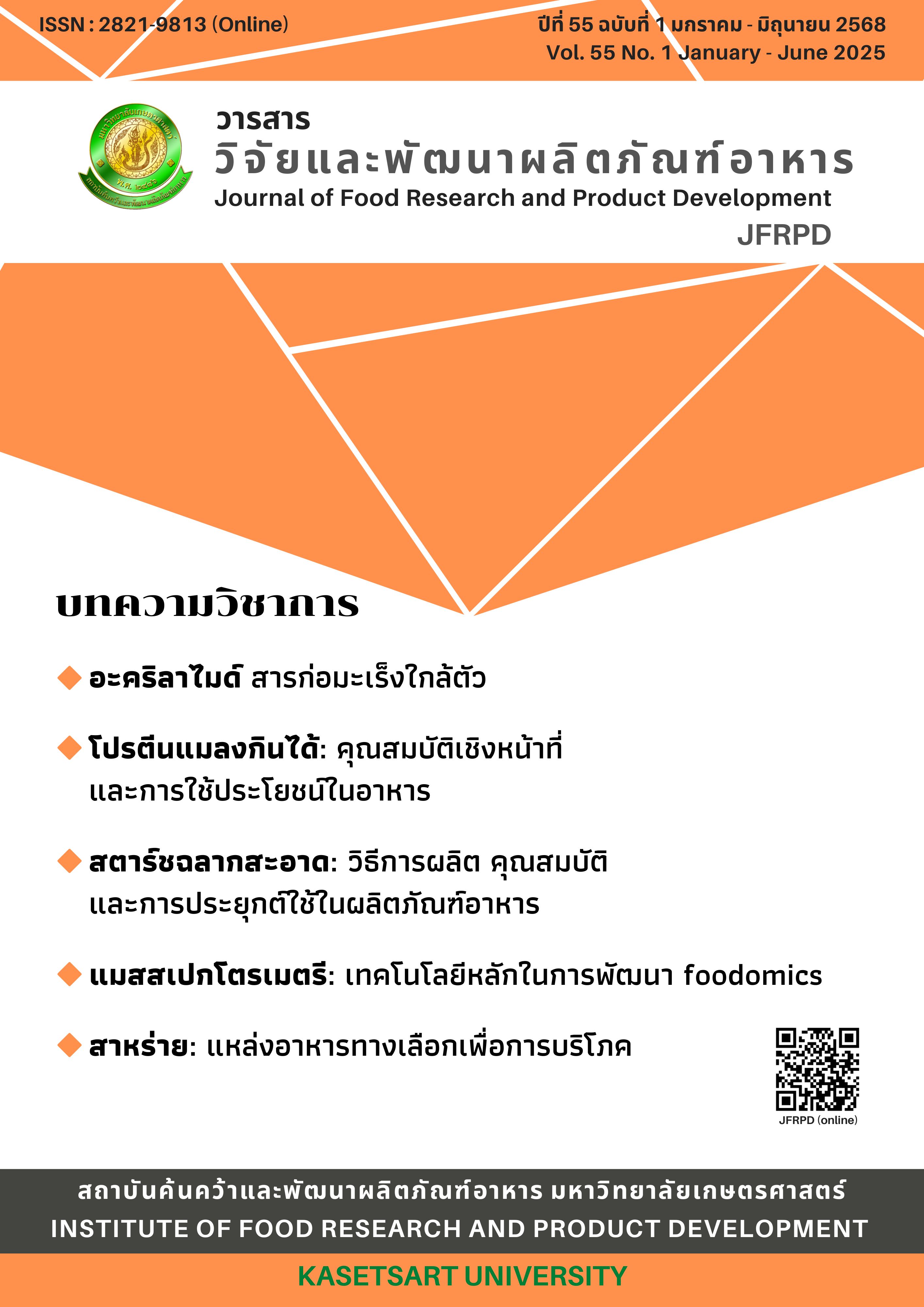สตาร์ชฉลากสะอาด: วิธีการผลิต คุณสมบัติ และการประยุกต์ใช้ในผลิตภัณฑ์อาหาร
##plugins.themes.bootstrap3.article.main##
บทคัดย่อ
แนวโน้มตลาดผลิตภัณฑ์อาหารเพื่อสุขภาพมีการเติบโตอย่างต่อเนื่อง สตาร์ชฉลากสะอาดหรือสตาร์ชดัดแปรโดยไม่ใช้สารเคมีจัดเป็นหนึ่งในส่วนประกอบที่มีบทบาทสำคัญต่อการเปลี่ยนแปลงของอุตสาหกรรมอาหาร การดัดแปรสตาร์ชด้วยวิธีต่าง ๆ โดยไม่ใช้สารเคมี เช่น การผสม วิธีทางกายภาพ (การใช้ความร้อน และไม่ใช้ความร้อน) และการใช้เอนไซม์ ส่งผลให้สตาร์ชมีคุณสมบัติแตกต่างกันไปขึ้นอยู่กับวิธีการ ชนิดของสตาร์ช และปัจจัยที่เกี่ยวข้อง สตาร์ชผสมส่วนใหญ่มีคุณสมบัติไม่เป็นไปตามค่าการทำนาย เทคนิคการใช้ความร้อนส่งผลให้สตาร์ชเกิดการเจลาติไนเซชันบางส่วน ส่วนการใช้เทคนิคการแปรรูปโดยไม่ใช้ความร้อนส่วนใหญ่ส่งผลต่อการเปลี่ยนแปลงรูปร่างและบริเวณผิวของกรานูล และบางวิธีอาจส่งผลให้โมเลกุลของสตาร์ชเกิดการเปลี่ยนแปลง การใช้เอนไซม์เป็นวิธีที่ทำให้คุณสมบัติของสตาร์ชเปลี่ยนแปลงไปมากเนื่องจากโครงสร้างโมเลกุลของสตาร์ชถูกไฮโดรไลซ์ สตาร์ชฉลากสะอาดยังคงเป็นเรื่องที่ท้าทายในการนำนวัตกรรมการผลิตมาประยุกต์ใช้ในอุตสาหกรรมแปรรูปอาหาร เพื่อให้เกิดผลลัพธ์ที่สามารถส่งต่อถึงผลิตภัณฑ์อาหารฉลากสะอาดสำหรับผู้บริโภค
##plugins.generic.usageStats.downloads##
##plugins.themes.bootstrap3.article.details##

This work is licensed under a Creative Commons Attribution-NonCommercial-NoDerivatives 4.0 International License.
เอกสารอ้างอิง
Osborn S. Labelling relating to natural ingredients and additives. In: Berryman P, editor. Advances in Food and Beverage Labelling. Oxford: Woodhead Publishing; 2015. p. 207-21.
Park S, Kim YR. Clean label starch: production, physicochemical characteristics, and industrial applications. Food Sci Biotechnol. 2021;30(1).
Mason WR. Starch use in foods. In: James N. BeMiller RLW, editor. Starch : Chemistry and Technology: Elsevier; 2009. p. 745-95.
Custom Market Insights. Global clean label starch market 2025-2034 updated December 6, 2024. Available from: https://www.custommarketinsights.com/report/clean-label-starch-market/
Presistence market research. Clean label starch market 2023 updated December 6, 2024. Available from: https://www.persistencemarketresearch.com/market-research/clean-label-starch-market.asp
Waterschoot J, Gomand SV, Fierens E, Delcour JA. Starch blends and their physicochemical properties. Starch/Staerke. 2015;67(1-2):1-13.
Puncha-arnon S, Pathipanawat W, Puttanlek C, Rungsardthong V, Uttapap D. Effects of relative granule size and gelatinization temperature on paste and gel properties of starch blends. Food Res Int. 2008;41(5):552-61.
Hagenimana A, Pu P, Ding X. Study on thermal and rheological properties of native rice starches and their corresponding mixtures. Food Res Int. 2005;38(3):257-66.
Chen JJ, Lai VMF, Lii CY. Effects of compositional and granular properties on the pasting viscosity of rice starch blends. Starch/Staerke. 2003;55(5):203-12.
Waterschoot J, Gomand SV, Delcour JA. Impact of swelling power and granule size on pasting of blends of potato, waxy rice and maize starches. Food Hydrocoll. 2016;52:69-77.
Lowithun N. Influence of molecular structure of starch on textural and rheological properties of blended rice gels [Thesis Ph.D. (Food Science)]. Bangkok, Thailand: Kasetsart University; 2023.
Noda T, Tsuda S, Mori M, Takigawa S, Matsuura-Endo C, Kim SJ, et al. Effect of potato starch properties on instant noodle quality in wheat flour and potato starch blends. Starch/Staerke. 2006;58(1):18-24.
Sun D, Yoo B. Effect of tapioca starch addition on rheological, thermal, and gelling properties of rice starch. LWT-Food Science and Technology. 2015;64(1):205-11.
Sasaki T, Kohyama K, Miyashita K, Okunishi T. Effects of Rice Flour Blends on Bread Texture and Staling. Cereal Chem. 2014;91(2):146-51.
Wu K, Dai S, Gan R, Corke H, Zhu F. Thermal and rheological properties of Mung Bean starch blends with potato, sweet potato, rice, and sorghum starches. Food Bioproc. Tech. 2016;9(8):1408-21.
Li S, Ye F, Zhou Y, Lei L, Zhao G. Rheological and textural insights into the blending of sweet potato and cassava starches: In hot and cooled pastes as well as in fresh and dried gels. Food Hydrocoll. 2019;89:901-11.
Stute R, Kern H, inventors; CPC International Inc., Englewood Cliffs, N.J., assignee. Starch mixtures as pudding starches. United States patent 5324532. 28 June 1994.
Wu Z, Qiao D, Zhao S, Lin Q, Zhang B, Xie F. Nonthermal physical modification of starch: An overview of recent research into structure and property alterations. Int J Biol Macromol. 2022;203:153-75.
Dhiman A, Prabhakar PK. Micronization in food processing: A comprehensive review of mechanistic approach, physicochemical, functional properties and self-stability of micronized food materials. J Food Eng. 2021;292:110248.
Zheng J, Li Q, Hu A, Yang L, Lu J, Zhang X, et al. Dual-frequency ultrasound effect on structure and properties of sweet potato starch. Starch/Staerke. 2013;65(7-8):621-7.
Carmona-García R, Bello-Pérez LA, Aguirre-Cruz A, Aparicio-Saguilán A, Hernández-Torres J, Alvarez-Ramirez J. Effect of ultrasonic treatment on the morphological, physicochemical, functional, and rheological properties of starches with different granule size. Starch/Staerke. 2016;68(9-10):972-9.
Nie H, Li C, Liu P-H, Lei C-Y, Li J-B. Retrogradation, gel texture properties, intrinsic viscosity and degradation mechanism of potato starch paste under ultrasonic irradiation. Food Hydrocoll. 2019;95:590-600.
Park SH, Na Y, Kim J, Kang SD, Park KH. Properties and applications of starch modifying enzymes for use in the baking industry. Food Sci Biotechnol. 2018;27(2):299-312.

